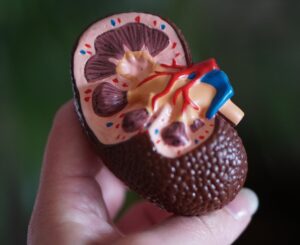 Celiac disease is an autoimmune systemic disorder, predominantly affecting the small intestine resulting in chronic inflammation. It is associated with gluten ingestion – a protein ingredient of wheat, rye, barley and oats. Susceptible and genetically predisposed individuals develop the disease in childhood or in adolescence. Common symptoms include diarrhea and signs of malabsorption, but the disease could occur with atypical manifestations such as anemia, dermatitis, osteopenia, infertility, nervous system involvement, behavioral disorders.Rare cases of acute onset of the disease in adulthood are published in the literature – celiac crisis. In this case typical are metabolic dysregulation, dyselectrolytemia, neurological disorders and higher mortality. We present a clinical case of a 39-year-old female patient with acute onset of the disease, anemia, diarrhea, electrolyte disorders, tetany, limb paresis. Serological, endoscopic and histologic findings confirm the diagnosis celiac disease. Gluten-free diet was then introduced, which led to clinical recovery. Read the full article here.
Celiac disease is an autoimmune systemic disorder, predominantly affecting the small intestine resulting in chronic inflammation. It is associated with gluten ingestion – a protein ingredient of wheat, rye, barley and oats. Susceptible and genetically predisposed individuals develop the disease in childhood or in adolescence. Common symptoms include diarrhea and signs of malabsorption, but the disease could occur with atypical manifestations such as anemia, dermatitis, osteopenia, infertility, nervous system involvement, behavioral disorders.Rare cases of acute onset of the disease in adulthood are published in the literature – celiac crisis. In this case typical are metabolic dysregulation, dyselectrolytemia, neurological disorders and higher mortality. We present a clinical case of a 39-year-old female patient with acute onset of the disease, anemia, diarrhea, electrolyte disorders, tetany, limb paresis. Serological, endoscopic and histologic findings confirm the diagnosis celiac disease. Gluten-free diet was then introduced, which led to clinical recovery. Read the full article here.
Featured posts
 On 10-11 September 2021, for 12th consecutive year, the Institute for Rare Diseases has organised the the National Conference for Rare Diseases and Orphan Drugs. The conference is an annual forum that brings together all stakeholders – health care professionals, patients, medical students, health authorities and industry. This year, 46 speakers took part in the Scientific Program and presented current topics related to innovations in the diagnosis, treatment and follow-up care for patients with rare diseases, the development of European reference networks and all latest news related to access to innovation. The Poster session included 29 scientific posters on various topics related to rare diseases. More than 80 interactive materials and videos accessible 24/7 are presented at the Virtual Booths of the Institute for Rare Diseases, the National Alliance of People with Rare Diseases and our industry partners.
On 10-11 September 2021, for 12th consecutive year, the Institute for Rare Diseases has organised the the National Conference for Rare Diseases and Orphan Drugs. The conference is an annual forum that brings together all stakeholders – health care professionals, patients, medical students, health authorities and industry. This year, 46 speakers took part in the Scientific Program and presented current topics related to innovations in the diagnosis, treatment and follow-up care for patients with rare diseases, the development of European reference networks and all latest news related to access to innovation. The Poster session included 29 scientific posters on various topics related to rare diseases. More than 80 interactive materials and videos accessible 24/7 are presented at the Virtual Booths of the Institute for Rare Diseases, the National Alliance of People with Rare Diseases and our industry partners.
The registered conference participants will have the opportunity, within the month of September, to view all recordings of the lectures, Scientific Posters and to visit the digital materials available at the Virtual Booths in the Virtual Congress Venue.
(Български) Доц. Ася Консулова – лектор на XII Национална конференция за редки болести и лекарства сираци
Sorry, this entry is only available in Bulgarian.
(Български) Проф. Емил Паскалев – лектор на XII Национална конференция за редки болести и лекарства сираци
Sorry, this entry is only available in Bulgarian.
(Български) Проф. Нина Гочева – лектор на XII Национална конференция за редки болести и лекарства сираци
Sorry, this entry is only available in Bulgarian.
(Български) Доц. Гергана Петрова – лектор на XII Национална конференция за редки болести и лекарства сираци
Sorry, this entry is only available in Bulgarian.
(Български) Проф. Савина Хаджидекова – лектор на XII Национална конференция за редки болести и лекарства сираци
Sorry, this entry is only available in Bulgarian.
 Primary hyperammonaemia is a term to describe an elevation of ammonia in blood or plasma due to a defect within the urea cycle, which is the pathway responsible for ammonia detoxification and arginine biosynthesis. Urea cycle disorders (UCDs) are rare diseases caused by genetic defects affecting any of the six enzymes or two transporters that are directly involved in the urea cycle function.The clinical situation is variable and largely depends on the time of onset. Newborns who are often affected by hyper-ammonaemic encephalopathy carry a potential risk of severe brain damage, which may lead to death. Outside the neonatal period, symptoms are very unspecific but most often neurological (with wide variability), psychiatric and/or gastrointestinal. Early identification of patients is extremely important to start effective treatment modalities immediately. The acute management includes detoxification of ammonia, which often requires extracorporeal means such as haemodialysis, and the use of intravenous drugs that work as nitrogen scavengers. Long-term management of patients with UCDs consists of a low-protein diet, which needs to be balanced and supplemented to avoid deficiencies of essential amino acids, trace elements or vitamins and the use of nitrogen scavengers.The reader will find here a brief overview describing the most relevant aspects of the clinical management of UCDs in an attempt to raise awareness for this important group of rare diseases. Read the whole article here.
Primary hyperammonaemia is a term to describe an elevation of ammonia in blood or plasma due to a defect within the urea cycle, which is the pathway responsible for ammonia detoxification and arginine biosynthesis. Urea cycle disorders (UCDs) are rare diseases caused by genetic defects affecting any of the six enzymes or two transporters that are directly involved in the urea cycle function.The clinical situation is variable and largely depends on the time of onset. Newborns who are often affected by hyper-ammonaemic encephalopathy carry a potential risk of severe brain damage, which may lead to death. Outside the neonatal period, symptoms are very unspecific but most often neurological (with wide variability), psychiatric and/or gastrointestinal. Early identification of patients is extremely important to start effective treatment modalities immediately. The acute management includes detoxification of ammonia, which often requires extracorporeal means such as haemodialysis, and the use of intravenous drugs that work as nitrogen scavengers. Long-term management of patients with UCDs consists of a low-protein diet, which needs to be balanced and supplemented to avoid deficiencies of essential amino acids, trace elements or vitamins and the use of nitrogen scavengers.The reader will find here a brief overview describing the most relevant aspects of the clinical management of UCDs in an attempt to raise awareness for this important group of rare diseases. Read the whole article here.
(Български) Доц. Анна Попова – лектор на XII Национална конференция за редки болести и лекарства сираци
Sorry, this entry is only available in Bulgarian.
(Български) Проф. Силвия Чернинкова – лектор на XII Национална конференция за редки болести и лекарства сираци
Sorry, this entry is only available in Bulgarian.
